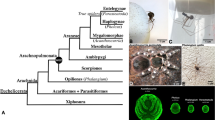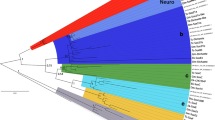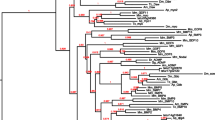Abstract
wingless (wg)/Wnt family genes encode secreted glycoproteins that function as signalling molecules in the development of vertebrates as well as invertebrates. In a survey of Wnt family genes in the newly sequenced Tribolium genome, we found a total of nine Wnt genes. In addition to wg or Wnt1, Tribolium contains orthologs of the vertebrate Wnt5–7 and Wnt9–11 genes. As in Drosophila, Wnt1, Wnt6 and Wnt10 are clustered in the genome. Comparative genomics indicates that Wnt9 is also a conserved member of this cluster in several insects for which genome sequence is available. One of the Tribolium Wnt genes appears to be a member of the WntA family, members of which have been identified in Anopheles and other invertebrates but not in Drosophila or vertebrates. Careful phylogenetic examination suggests an Apis Wnt gene, previously identified as a Wnt4 homolog, is also a member of the WntA family. The ninth Tribolium Wnt gene is related to the diverged Drosophila WntD gene, both of which phylogenetically group with Wnt8 genes. Some of the Tribolium Wnt genes display multiple overlapping expression patterns, suggesting that they may be functionally redundant in segmentation, brain, appendage and hindgut development. In contrast, the unique expression patterns of Wnt5, Wnt7 and Wnt11 in developing appendages likely indicate novel functions.




Similar content being viewed by others
References
Angelini DR, Kaufman TC (2005) Functional analyses in the milkweed bug Oncopeltus fasciatus (Hemiptera) support a role for Wnt signaling in body segmentation but not appendage development. Dev Biol 283:409–423
Baker NE (1988) Localization of transcripts from the wingless gene in whole Drosophila embryos. Development 103:289–298
Brown SJ, Parrish JK, Beeman RW, Denell RE (1997) Molecular characterization and embryonic expression of the even-skipped ortholog of Tribolium castaneum. Mech Dev 61:165–173
Choe CP, Miller SC, Brown SJ (2006) A pair-rule gene circuit defines segments sequentially in the short-germ insect Tribolium castaneum. Proc Natl Acad Sci USA 103:6560–6564
Cohen ED, Mariol M, Wallace RMH, Weyers J, Kamberov YG, Pradel J, Wilder EL (2002) DWnt4. regulates cell movement and focal adhesion kinase during Drosophila ovarian morphogenesis. Dev Cell 2:437–448
Dearden PK, Wilson MJ, Sablan L, Osborn PW, Havler M, McNaughton E, Kimura K, Milshina NV, Hasselmann M, Gempe T, Schioett M, Brown SJ, Elsik CG, Holland PWH, Kadowaki T, Beye M (2006) Patterns of conservation and change in honey bee developmental genes. Genome Res 16:1376–1384
Fradkin LG, Noordermeer JN, Nusse R (1995) The Drosophila Wnt protein DWnt-3 is a secreted glycoprotein localized on the axon tracts of the embryonic CNS. Dev Biol 168:202–213
Ganguly A, Jiang J, Ip T (2005) Drosophila. WntD is a target and an inhibitor of the orsal/Twist/Snail network in the gastrulating embryo. Development 132:3419–3429
Gordon MD, Dionne MS, Schneider DS, Nusse R (2005) WntD is a feedback inhibitor od Dorsal/NF-kB in Drosophila development and immunity. Nature 437:746–749
Grimaldi D, Engel MS (2005) Evolution of the Insects. Cambridge Univ. Press, Cambridge
Ingham PW, Hidalgo A (1993) Regulation of wingless transcription in the Drosophila embryo. Development 117:283–291
Janson K, Cohen ED, Wilder EL (2001) Expression of DWnt6, DWnt10, and DFz4 during Drosophila development. Mech Dev 103:117–120
Klingler M, Gergen JP (1993) Regulation of runt transcription by Drosophila segmentation genes. Mech Dev 43:3–19
Kozopas KM, Samos CH, Nusse R (1998) DWnt-2. , a Drosophila Wnt gene required for the development of the male reproductive tract, specifies a sexually dimorphic cell fate. Genes Dev 12:1155–1165
Kusserow A, Pang K, Sturm C, Hrouda M, Lentfer J, Schmidt HA, Technau U, Haeseler AV, Hobmayer B, Martindale MQ, Holstein TW (2005) Unexpected complexity of the Wnt gene family in a sea anemone. Nature 433:156–160
Miyawaki K, Mito T, Sarashina U, Zhang H, Shinmyo Y, Ohuchi H, Noji S (2004) Involvement of Wingless/Armadillo signaling in the posterior sequential segmentation in the cricket, Gryllus bimaculatus (Orthoptera), as revealed by RNAi analysis. Mech Dev 121:119–130
Nagy L, Carroll S (1994) Conservation of wingless patterning functions in the short-germ embryos of Tribolium castaneum. Nature 367:460–463
Nusse R (2001) An ancient cluster of Wnt paralogues. Trends Genet 17:443
Nusse R, Varmus HE (1992) Wnt. genes. Cell 69:1073–1087
Prud’homme B, Lartillot N, Balavoine G, Adoutte A, Vervoort M (2002) Phylogenetic analysis of the Wnt gene family: insights from lophotrochozoan members. Curr Biol 12:1395–1400
Russell J, Gennissen A, Russe N (1992) Isolation and expression of two novel Wnt/wingless gene homologues in Drosophila. Development 115:475–485
Savard J, Marques-Souza H, Aranda M, Tautz D (2006) A segmentation gene in Tribolium produces a polycistronic mRNA that codes for multiple conserved peptides. Cell 126:559–569
Strimmer K, von Haeseler A (1996) Quartet puzzling: a quartet maximum likelihood method for reconstructing tree topologies. Mol Biol Evol 13:964–969
Sullivan JC, Ryan JF, Mullikin JC, Finnerty JR (2007) Conserved and novel Wnt clusters in the basal eumetazoan Nematostella vectensis. Dev Genes Evol 217:235–239
Tautz D, Pfeifle C (1989) A non-radioactive in situ hybridization method for the localization of specific RNAs in Drosophila embryos reveals translational control of the segmentation gene hunchback. Chromosoma 98:81–85
Acknowledgements
The work of R. Bolognesi, L. Farzana and S. Brown is supported by NIH grant HD29594. A. Beermann and R. Schröder thank R. Reuter for continuous support, T. Mader for technical assistance and the German Research Council (DFG) for funding (SCHR 4435/3-1/3/2).
Author information
Authors and Affiliations
Corresponding authors
Additional information
Communicated by: S. Roth
Renata Bolognesi and Anke Beermann are equal first authors.
Susan J. Brown and Reinhard Schröder are equal corresponding authors.
Rights and permissions
About this article
Cite this article
Bolognesi, R., Beermann, A., Farzana, L. et al. Tribolium Wnts: evidence for a larger repertoire in insects with overlapping expression patterns that suggest multiple redundant functions in embryogenesis. Dev Genes Evol 218, 193–202 (2008). https://doi.org/10.1007/s00427-007-0170-3
Received:
Accepted:
Published:
Issue Date:
DOI: https://doi.org/10.1007/s00427-007-0170-3




